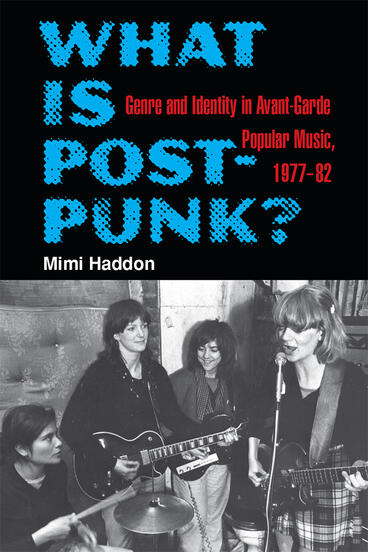What Is Post-Punk?
Genre and Identity in Avant-Garde Popular Music, 1977-82
Is post-punk a genre? Where did it come from? And what does it mean?
Description
Popular music in the US and UK during the late 1970s and early 1980s was wildly eclectic and experimental. “Post-punk,” as it was retroactively labeled, could include electro-pop melodies, distorted guitars, avant-garde industrial sounds, and reggae beats, and thus is not an easily definable musical category.
What Is Post-Punk? combines a close reading of the late-1970s music press discourse with musical analyses and theories of identity to unpack post-punk’s status as a genre. Mimi Haddon traces the discursive foundations of post-punk across publications such as Sounds, ZigZag, Melody Maker, the Village Voice, and NME, and presents case studies of bands including Wire, PiL, Joy Division, the Raincoats, and Pere Ubu. By positioning post-punk in relation to genres such as punk, new wave, dub, and disco, Haddon explores the boundaries of post-punk, and reveals it as a community of tastes and predilections rather than a stylistically unified whole. Haddon diversifies the discourse around post-punk, exploring both its gender and racial dynamics and its proto-industrial aesthetics to restore the historical complexity surrounding the genre’s terms and origins.
Mimi Haddon is Senior Lecturer in Music in the School of Media, Arts and Humanities at the University of Sussex.
Reviews
“Building on extensive media research and paying specific attention to the distinctions between labels such as punk, new wave and avant-garde, Haddon carefully reconstructs the beginnings of post-punk and questions its generic boundaries. . . . Five comprehensive chapters explore the rich identity politics, genre transgressions and boundaries, stylistic nuances and aesthetics of various musical groupings that are nowadays frequently positioned within the post-punk realm.”
- Popular Music
—Popular Music
"A fascinating insight into a musical label that—more than 40 years on—still defies categorisation."
- Allan Glen
—Record Collector
“Mimi Haddon expertly unpicks the tangled threads of cynicism, noise, disco, dub and decay which are woven together in post-punk. A compelling portrait of an intoxicating musical moment and a significant contribution to genre theory.”
- Caspar Melville
—Caspar Melville, SOAS, University of London
“Haddon provides keen insights into the interplay of images, sounds, words, and performance in post-punk. A fresh look at how gender, race, and media discourse critically shaped a genre.”
- Ellie M. Hisama
—Ellie M. Hisama, Columbia University
"Mimi Haddon’s What Is Post-Punk? dismantles a deceptively simple question with care, beginning a long-overdue conversation that, as Haddon herself reveals, has already been happening online and in the music press for years. . . . Haddon’s approach is academic but not prescriptive, carefully introducing a diverse set of critical frameworks that will be invaluable for future writers."
- Claudia Lonkin
—Punk & Post-Punk

